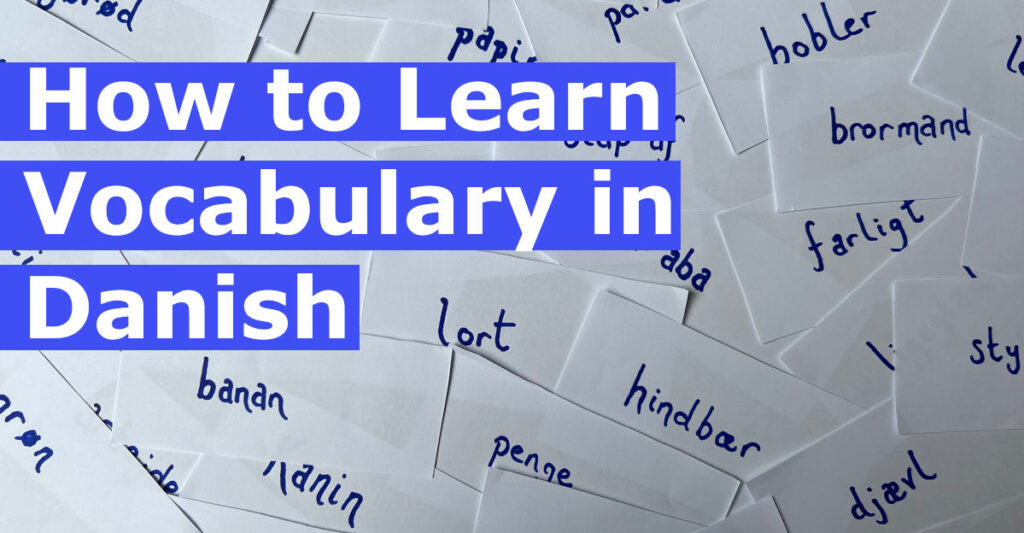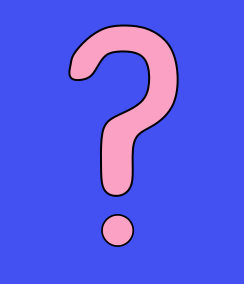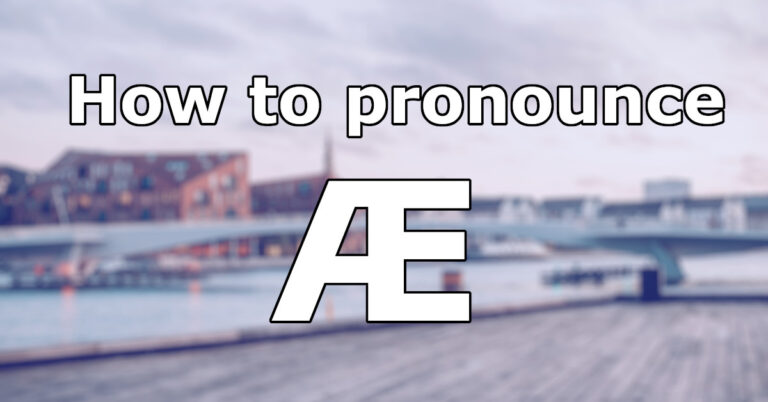10 Ways to Expand your Danish Vocabulary

One of the big challenges when learning a new language is building your vocabulary. Just learning a few new words is difficult enough – the thought of learning hundreds if not thousands of them is overwhelming.
My philosophy is that language learning should be fun. And I really don’t like sitting learning lists of words like I was forced to do in the classroom. So let’s look at 10 ways to expand your Danish vocabulary, without it feeling like a chore.
The good news is, learning vocabulary doesn’t have to be boring – especially when it comes to Danish.
In fact, I think that having a large vocabulary is overrated. As a beginner, you really just need to know enough to keep the conversation going – and through conversation, you are going to pick up more and more words.
At the intermediate level, you can use some specific, enjoyable techniques to help expand your vocabulary even further.
For the beginners (and everybody else) – how to expand your Danish vocabulary FAST
1. Similarities between Danish and English
One quick way to build your Danish vocabulary is to understand the history of English, and its relation to Danish.
To keep it short, modern English is basically a blend of old germanic languages, brought by the Vikings, and French, brought by the Normans. When the Normans introduced French, it became the language of power and the upper classes, with the Germanic language begin associated with the lower classes.
As a result, many concepts in English have two words relating the same thing. For example, when we refer to the animal in the field, we use the word ‘cow’. When we talk about the meat on the plate, we refer to it as ‘beef’. The word ‘cow’ comes from the Germanic, the people working the land, and is similar to the Danish ‘ko’. ‘Beef’, on the other hand, comes from the upper class who were eating the meat, and is similar to the French ‘boeuf’.
This is just one of dozens of example (think of verbs – ‘start’ as opposed to ‘commence’, body parts – lungs as opposed to pulmonary). In general, words of Germanic origin remained in English to refer to everyday things. Words of French origin were used to refer to concepts, law, science and medicine.
This is useful for us because a lot of the vocabulary we will come across in Danish will be very similar to English – numbers, days, months, common verbs, body parts, materials. Looking at the 1000 most common words in Danish, around half have a direct connection to their English counterpart.
Focusing on the connection to English can help us to remember new words. Let’s take the word for city – ‘by’. It may not look related to English at first, but think of all the place names in England with ‘by’ at the end – Derby, Grimsby, Whitby. These towns were named by the Vikings. We actually still use ‘by’ in English when we refer to a local law as a by-law.
This may seem like a lot of work to learn one word but what you are doing here is getting better at language in general and using story to help you understand, rather than just remember.
Many people recommend using mnemonics to learn new words, meaning that you will come up with some sort of fantastical story that connects the word to something in English. Well, with Danish, the story already exists, so you not only remember the words but gain a deeper understanding of both languages and the history of the countries.
With just a little work, you can quickly build up a strong vocabulary covering a lot of the most common words in the language. And with a curious mind, you can start to make more and more connections, until the point that Danish starts to feel like English with a funny accent.
2. Speak

Speaking is the number one way to improve your vocabulary as a beginner. You get to hear a load of new words, and you get to practise the new words that you have learnt. No flashcard or cool remembering technique will help you remember words faster than actually using them in conversation.
And not only that – using words in conversation will increase your speed at picking these words out in a real life scenario. You will also quickly learn which words are important, which words you lack, and which words are important to you, based on your own interests and topics of conversation.
3. Learn the most important phrases to get started
So how do we get to the stage where we can simply ‘speak’ and have a conversation. As a complete beginner, having a conversation is a big ask.
To get over this challenge, it is a good idea to learn the most basic phrases of the language – learn how to introduce yourself, some basic verbs and some conjunctions to start to put sentences together (conjunctions being words like ‘and’, ‘but’, ‘because’). Don’t worry too much about learning nouns, you can pick these up by asking in conversation.
One other great way to get going with conversation is to learn how to:
4. Learn how to ask questions
Asking questions is a great way to get started with having a conversation in a new language. Think of these two scenarios:
1. Someone asks you how you are in Danish. You are outside, it’s noisy, you aren’t ready for the question. Even though you maybe know the words, you don’t understand them. And so you say ‘sorry’ in English, or you ask them to repeat themselves and they switch to English.

2. You ask someone in Danish how they are. They reply to you and you don’t understand fully but you can hear from their inflection and the way they look at you that they have asked something back. So you guess that they asked how you are and you answer that you are well, then follow up back asking them what their plans for the day are.
As you can see from these 2 situations, if you learn to ask questions, you can lead the conversation, which means that you can practise for longer and learn more things before feeling overwhelmed or switching to English.
5. Forget grammar
Nothing will stunt your progress more than paying too much attention to grammar. It will cause you to freeze up in conversation, and lose the confidence to just speak.
So, let’s say that you’ve learnt that the word ‘gå’ means go, but you don’t know the word for went? Don’t worry about it. Just use the word go. If necessary, use other words or body language to make it clear it was in the past – did it happen yesterday? Say, i går and they’ll get the point. If you’re lucky the other person might reuse the verb in the past or correct you, and then you’ll know for next time.
6. Work on your pronunciation
If the goal is learning vocabulary, pronunciation work may seem superfluous, but I stand by the concept that working on your pronunciation is the single most important thing you can do to improve your Danish. Working on pronunciation means that you will understand more, which means that you will pick up words more quickly, and that you will be understood, meaning that conversations will flow better and you will get more conversation practice.
If you want to improve your pronunciation, you can follow the tips laid out in this Danish Pronunciation Guide.
Intermediate learners – take your Danish vocabulary to the next level
7. Input – TV, film, music, books
Once you’ve got to grips with the basics of the language, it’s time to start taking a lot of language in. Following the personalisation theory, this means finding something you are interested in, and becoming obsessed with it. If you like a particular singer, learn to sing along to their songs, watch interviews with them, read about them.
All of this input can be done in 2 ways – broad understanding or skimming, and focused study. If you like to read the news, you can skim different articles to get a general idea of the meaning and build an interest. If you like a Danish band, you can listen to their songs repeatedly until you have a general idea of what they are about. This will help maintain your motivation without getting bogged down in the details.
For focused work, you can take a small snippet of a song, slow it down and learn to sing along perfectly. Alternatively, you can take a small section of something you are reading and apply the ‘bidirectional translation’ described below.
8. Bidirectional translation
This is a method I picked up from Luca Lampariello and is an amazing way to rapidly improve your grammar and vocabulary. Basically, you want to take a small piece of text, that ideally has an accompanying audio. Many Danish news websites are perfect for this as they have an audio version of their articles, including the free DR.
On Day 1 you will read and listen to your text (just a few sentences) and write it down in Danish. On Day 2 you will translate it into English. On Day 3 you will translate it back into Danish without looking at the original text. Then compare with the original and correct any mistakes.
If you enjoy this method, you can build it up by having 3 texts on the go at once – one text on Day 1, one on Day 2, and one on Day 3.
Even though you only work with small portions of text, the act of translating them back into Danish really reinforces them in your brain and helps you build up a strong knowledge of vocabulary and grammar.
9. Language islands
Another great way to improve beyond the intermediate stage is the concept of language islands.
Language islands is a technique described by Boris Shekhtman in his book How to Improve your Foreign Language Immediately.
The idea is this. Speaking a language is a bit like moving. When you speak your native language, it is like walking on solid ground – it doesn’t take too much energy and you can do it without thinking about it.
Speaking a second language, however, is like swimming – you can still move, but it tires you out quickly and requires a lot more coordination.
A language island, then, is a topic in a second language in which you are super comfortable. This topic gives you a break from the swimming and an opportunity to land and get your breath back. Most people have a language island of introducing themselves and talking about family.
If you want to improve your vocabulary, you want to build up more islands. Think of a topic in which you want to be really comfortable? Are you a big sports fan and often talk about football in English? Then start learning vocabulary related to football in Danish. Listen to some football podcasts, watch videos, read articles and make note of how language is used around this topic – and then set yourself up some conversations in which you can apply it.
The more language islands you have, the more fluent your conversations will be.
10. Compound words
One of the great things about Danish is that it is made up of many compound words. So if you know one word, you can just add different parts to make a whole series of new words! A great way to improve your vocabulary is to take a word you already know and see how many different ways in which it can be used. This way, you don’t need to commit new words to memory, just new contexts.
Let’s take the word ‘del’ as an example. Del means ‘part’ as a noun and ‘share’ as a verb, but it can be used to make many other words:
Deltage – partake
Deltid – part-time
Kropsdel – body part
Nederdel – skirt
Tredjedel – third
Procentdel – percentage
Runddel – roundabout
Overdel – top part
Underdel – bottom part
Bydel – district (city part)
Bagdel – back
Afdeling – department
Opdel – split
Delebarn – when a child lives part time with one parent
Taking one word that can be altered and applied in many different context will rapidly increase your ability to speak confidently in a variety of situations. Remember to use these words in conversation in order to cement them in your working vocabulary.
Conclusion
Expanding your Danish vocabulary doesn’t have to be a daunting task filled with endless lists and rote memorisation. Instead, it can be a journey of connection —linking words to history, culture, and personal experiences to make them stick.
Remember, language learning is not just about accumulating words; it’s about opening doors to new worlds, understanding different cultures, and connecting with people on a deeper level. By focusing on the similarities between English and Danish, engaging in conversations, and immersing yourself in the language through media, you’re not just learning to speak another language, you’re learning to live it.
Dive head first into conversation and don’t let perfectionism get in the way. Embrace the mistakes, celebrate the small victories, and always keep the conversation going. Whether you’re a beginner just starting to navigate the waters or an intermediate learner ready to dive deeper, the strategies we’ve discussed are stepping stones to fluency.






